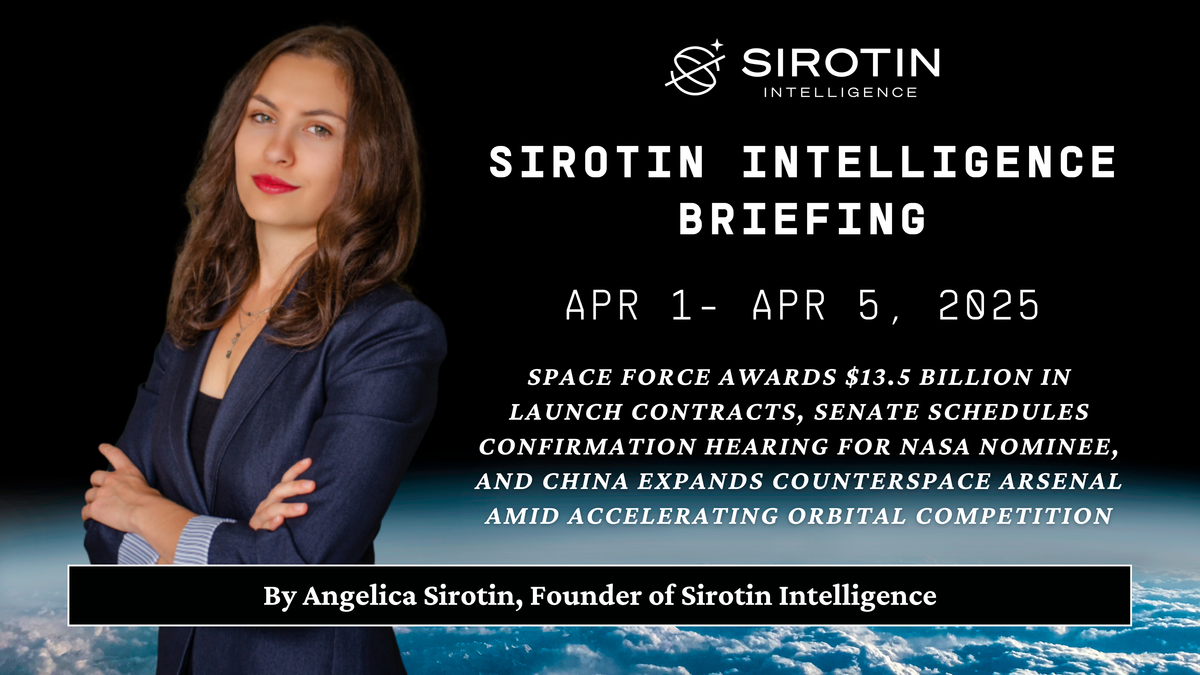Sirotin Intelligence Briefing: Apr 1 - Apr 5, 2025: Space Force Awards $13.5 Billion In Launch Contracts, Senate Schedules Confirmation Hearing For NASA Nominee, And China Expands Counterspace Arsenal Amid Accelerating Orbital Competition
Space Force Awards $13.5 Billion In Launch Contracts, Senate Schedules Confirmation Hearing For NASA Nominee, And China Expands Counterspace Arsenal Amid Accelerating Orbital Competition

Welcome to the Sirotin Intelligence Briefing for April 1-5, 2025. This week's highlights include the landmark $13.5 billion military launch contracts awarded to SpaceX, ULA, and Blue Origin, and alarming reports of China's space warfare exercises targeting U.S. military assets. Senior Intelligence Contributor Christophe Bosquillon provides critical insights from the U.S.-China Commission hearing, emphasizing the urgent need for an integrated space strategy that combines commercial and military capabilities. Don't miss our upcoming special edition with BOA member Guy Thomas on maritime security and cable attacks, followed by Part 2 of our conversation with Christopher Janette on BlackStar Orbital's revolutionary "hypersonic satellites." Keep reading for more!
🛡️ Defense Highlights
- SpaceX, ULA, and Blue Origin Win $13.5 Billion in Military Launch Contracts: The U.S. Space Force has awarded contracts worth a combined $13.5 billion to SpaceX ($5.9B), United Launch Alliance ($5.4B), and Blue Origin ($2.3B) to launch approximately 54 of the Pentagon's most sensitive satellites through 2029. This Phase 3 "Lane 2" procurement represents the Space Force's flagship launch program for its most challenging and costly missions.
- Sierra Space Demonstrates Resilient GPS Technology for Space Force: Sierra Space has successfully demonstrated its Resilient GPS (R-GPS) technology developed with General Dynamics Mission Systems, generating all required GPS navigation signals including P(Y), M-code, and C/A signals at L1 and L2 frequencies. This technology is designed to withstand threats such as jamming and spoofing, strengthening the nation's GPS resilience in an increasingly contested space environment.
- Vandenberg Teen Wins U.S. Space Force Military Child of the Year Award: Natalia Serna, daughter of Space Launch Delta 30's senior enlisted leader Chief Master Sgt. Jay Harris, has been recognized as the U.S. Space Force's Military Child of the Year by Operation Homefront. Throughout her father's deployments and after attending seven schools in 11 years, Natalia has demonstrated remarkable resilience, leadership, and commitment to supporting other military youth.
- NATO Attends 1st Space Brigade Joint Army Space Operations Demo: Senior military officials from dozens of NATO-member countries witnessed a demonstration at Fort Carson showing how U.S. Army close-combat space capabilities support multidomain large-scale combat operations. The demonstration included an air assault simulation with a CH-47 Chinook helicopter deploying a tactical space electromagnetic reconnaissance system, highlighting how air and ground forces integrate with Army space assets to secure positional advantage in austere environments.
- U.S. Space Force Developing Revolutionary Orbital Carrier: Gravitics, Inc. has secured significant funding through SpaceWERX's Strategic Funding Increase (STRATFI) program to develop an "orbital carrier" platform. This revolutionary system will serve as a mobile launch pad stationed in orbit, capable of deploying multiple maneuverable space vehicles on demand, providing unprecedented tactical advantages for responding to emerging threats in space.
- Auburn University Establishes Nation's Only University-Led Radiation Hardening Facility: Backed by an $11.4 million Department of Defense contract through the Missile Defense Agency, Auburn University's Applied Research Institute is creating a cutting-edge radiation hardening facility in Huntsville's Cummings Research Park. The facility will address a critical national shortage in radiation hardening infrastructure and ensure the reliability of military technology in the harsh radiation environments of space.
- China Practices for Space Warfare Against U.S. Military: Reports indicate China is conducting exercises simulating space-based conflict scenarios targeting U.S. military assets. These drills focus on developing capabilities to neutralize American satellite networks and other space-based infrastructure that support military operations, highlighting the growing competition in the space domain.
- Army Awards $4.9 Billion Contract for Precision Strike Missile: U.S. Army Contracting Command-Redstone Arsenal has awarded Lockheed Martin Missiles and Fire Control an indefinite-delivery, indefinite-quantity contract with a ceiling value of $4.9 billion. The initial delivery order includes 400 Precision Strike Missile (PrSM) Increment 1 missiles, representing a significant investment in the Army's long-range precision fires capability.
- U.S. Space Force Chief Warns of China's Destabilizing Space Capabilities: Chief of Space Operations Gen. Chance Saltzman has identified China's rapidly expanding space capabilities as a significant destabilizing force, highlighting concerns about their growing counterspace arsenal and ability to threaten U.S. space assets. Saltzman emphasized the need for the U.S. to accelerate development of resilient space architectures to counter these emerging threats.
- China Expands Counterspace Arsenal According to New Report: A comprehensive new assessment reveals China has significantly expanded its counterspace capabilities, developing a range of systems designed to disrupt, degrade, or destroy adversary satellites. The report details advancements in direct-ascent anti-satellite weapons, co-orbital systems, directed energy weapons, and sophisticated electronic warfare capabilities, representing a growing threat to U.S. space dominance.
- Russia and China Target SpaceX's Starlink in Escalating Space Electronic Warfare: Intelligence reports indicate Russia and China are intensifying electronic warfare efforts against SpaceX's Starlink constellation, employing sophisticated jamming techniques and potential cyber operations. These activities represent a concerning escalation in space-based electronic warfare as adversaries seek to neutralize the strategic advantages provided by commercial satellite networks supporting both civilian and military applications.
🌐 Policy, Geopolitical & Legal Developments
- NASA Updates Asteroid 2024 YR4 Impact Probability: NASA has revised the chance of asteroid 2024 YR4 impacting the Moon on December 22, 2032, from 1.7% to 3.8% based on new data from the James Webb Space Telescope and ground-based observations. Theasteroid, which poses no threat to Earth, is now estimated to be 174-220 feet (53-67 meters) in size, comparable to a 10-story building.
- Finland Updates Radio Frequency Rules to Benefit Space Tech: Finland has revised its radio frequency regulations to create more favorable conditions for private networks, space technology, and license-exempt devices. The updated rules aim to foster innovation in the space sector while ensuring compliance with international standards.
- Redstone Arsenal Enhances Space Defense Capabilities: Redstone Arsenal has announced new initiatives to strengthen space defense infrastructure and collaboration with industry partners. These efforts focus on developing advanced technologies to protect critical space assets and enhance military readiness in the increasingly contested space domain.
- Department of the Navy Approves Participation in Sea-Air-Space 2025 Symposium: The Department of the Navy has authorized attendance for its military and civilian personnel at the upcoming Sea-Air-Space Symposium, to be held April 6–9, 2025, at National Harbor, Maryland. Acting Under Secretary of the Navy Terrence Emmert signed a memorandum approving travel for Navy League symposium speakers, panelists, and moderators, while uniformed and civilian personnel in the National Capital Region may attend locally.
- Senate Schedules Confirmation Hearing for Isaacman's NASA Leadership Nomination: The Senate has announced a confirmation hearing for billionaire entrepreneur Jared Isaacman's nomination to lead NASA. Isaacman, who previously commanded the Inspiration4 private astronaut mission and is currently involved in SpaceX's Polaris Program, faces scrutiny regarding his qualifications to head the space agency during a critical period of lunar exploration and Mars planning.
- France Urges EU to Speed Up IRIS² Satellite Constellation: French Armed Forces Minister Sébastien Lecornu is pushing the European Commission to accelerate deployment and increase funding for the IRIS² sovereign satellite constellation. Originally targeted for completion by 2027, the project has been delayed to the early 2030s, raising concerns about Europe's strategic autonomy in space-based communications.
🛰️ Technology & Commercial Developments
- Australian Plant Monitoring Technology Heads to Space: The University of Southern Queensland (UniSQ) is leading an iLAUNCH Trailblazer project to test machine vision algorithms for monitoring plant health in microgravity. This technology will be crucial for sustainable food production in long-term space missions while offering commercial applications for Earth-based agriculture.
- Project Kuiper Prepares for Operational Satellite Launch: Amazon's satellite internet initiative is readying its long-awaited operational satellite launch, marking a significant milestone in the company's plan to deploy a constellation that will compete with SpaceX's Starlink in the global broadband market.
- Slingshot Aerospace Adapts Satellite Fingerprinting for Military Use: The company is modifying its satellite identification technology, originally developed for commercial applications, to meet military requirements. This adaptation will enhance space domain awareness capabilities for defense customers seeking to identify and track objects in orbit.
- MDA Space Acquires SatixFy to Enhance Constellation Production: MDA Space has purchased satellite communications component manufacturer SatixFy to bolster its constellation production capabilities, positioning the company to better compete in the growing market for satellite constellation development and deployment.
- JAXA Studies New Mars Lander Concept: The Japanese Aerospace Exploration Agency's institute is developing a Mars lander concept, potentially expanding Japan's planetary exploration capabilities beyond its current lunar and asteroid missions to reach the Red Planet.
- Commercial Lunar Lander Companies Seek Expanded Opportunities: Companies participating in NASA's Commercial Lunar Payload Services (CLPS) program are looking beyond their initial NASA contracts to develop additional applications and markets for their lunar lander technologies, including potential commercial and international customers.
- China Launches Internet Technology Test Satellites: China has successfully launched a new batch of internet technology test satellites using a Long March 2D rocket. These satellites will join the country's growing constellation aimed at providing enhanced communications capabilities and expanding China's presence in the global satellite internet market.
- GITAI Finalizes Robotic Arm Study for Japan's Crewed Lunar Rover: Japanese space robotics company GITAI has completed its study on developing a specialized robotic arm for Japan's planned crewed lunar rover. The robotic system is designed to perform complex tasks on the lunar surface, reducing risks for astronauts and enhancing the efficiency of lunar exploration activities.
- NASA Monitors Magnetic Field Anomaly: NASA scientists are closely tracking a significant anomaly in Earth's magnetic field, collecting data to better understand its causes and potential impacts. This research is crucial for protecting satellite infrastructure and improving space weather prediction capabilities that affect both orbital and terrestrial systems.
- Hylenr Partners with TakeMe2Space for LENR-Powered Space Tech: Hyderabad-based startup Hylenr Technologies has signed an MoU with space-tech company TakeMe2Space to develop and test Low Energy Nuclear Reactor (LENR) powered compute modules in space. TakeMe2Space will provide the satellite platform and subsystems required to test Hylenr's LENR-based thermoelectric generator, which could potentially enable long-duration missions, high-power computing in space, and reduced reliance on traditional power sources.
- FRAM2 Completes Polar Orbit Private Astronaut Mission: The second private astronaut mission to polar orbit has successfully concluded, marking another milestone in commercial human spaceflight. The mission demonstrated growing capabilities for private sector operations in previously government-dominated orbital regimes.
- Startups Demonstrate In-Orbit Satellite Autonomy: Multiple space startups have successfully demonstrated new autonomous capabilities for satellites in orbit, showcasing technologies that allow spacecraft to make independent decisions without ground control input. These advancements promise to enhance satellite resilience, reduce operational costs, and enable more complex missions with minimal human intervention.
- Auburn University Acquires Multimillion-Dollar Cyclotron for Space Radiation Simulation: As part of its new radiation hardening facility, Auburn University has purchased a cyclotron previously used for cancer treatment therapy. This particle accelerator will serve as the centerpiece of the institute's radiation hardening arsenal, allowing researchers to simulate space radiation and test the resilience of microelectronics destined for space applications.
- SpinLaunch Announces Plans for Broadband Satellite Constellation: SpinLaunch, known for its kinetic launch system that uses a massive accelerator to catapult payloads into space, has revealed plans to develop its own broadband satellite constellation. The company aims to leverage its unique launch capabilities to deploy a network of communications satellites at significantly reduced costs compared to traditional rocket launches.
- Voyager Technologies to Acquire LeoCloud: Voyager Technologies has announced plans to acquire LeoCloud, a provider of cloud computing services optimized for space-based applications. This strategic acquisition will enhance Voyager's capabilities in satellite data processing and expand its portfolio of space infrastructure services, positioning the company as a more comprehensive provider in the growing space technology ecosystem.
- Portal Space Systems Raises $17.5 Million for Highly Maneuverable Spacecraft: Portal Space Systems has secured $17.5 million in funding to accelerate development of its "Supernova" spacecraft, designed with unprecedented maneuverability in orbit. The vehicle's advanced propulsion system enables rapid repositioning and extended operational lifespans, offering potential applications in satellite servicing, debris removal, and responsive space operations.
- Vast Signs Agreement to Test Haven-1 Space Station at NASA Facility: Commercial space habitat company Vast has signed an agreement to test components of its Haven-1 commercial space station at NASA facilities. This partnership will allow Vast to validate critical systems before launch, advancing development of what could become the first commercial successor to the International Space Station as NASA prepares for the ISS's eventual retirement.
- Washington Harbour Partners Invests in Turion Space: Venture capital firm Washington Harbour Partners has made a strategic investment in Turion Space, a startup developing spacecraft for in-space services including debris removal and satellite inspection. This funding will accelerate Turion's development of technologies essential for maintaining sustainable operations in increasingly congested orbital environments.
- NASA Seeks Proposals for Two New Private Astronaut Missions: NASA is soliciting proposals for two additional private astronaut missions to the International Space Station, targeted for 2026 and 2027. These would be the fifth and sixth private missions coordinated by NASA, with each potentially docked to the ISS for up to 14 days. Proposals are due by May 30, 2025.
- NASA Astronaut Chris Williams Assigned to First ISS Mission: NASA astronaut Chris Williams will embark on his first mission to the International Space Station in November 2025, launching aboard the Roscosmos Soyuz MS-28 spacecraft with cosmonauts Sergey Kud-Sverchkov and Sergei Mikaev. The mission is expected to last approximately eight months, with Williams conducting scientific investigations and technology demonstrations.
- SpaceX Secures Majority of Initial Space Force Missions: SpaceX is anticipated to receive the majority of missions assigned by the Space Force in the program's initial year, as its launch frequency with the Falcon 9 far surpasses that of ULA and Blue Origin. The company will employ both the Falcon 9 and the more powerful Falcon Heavy for the Phase 3 missions.
- Blue Origin Enters National Security Launch Market: With seven missions valued at $2.3 billion, Blue Origin has officially entered the national security launch market. However, the company's New Glenn rocket, which has only launched once in January, has significantly less experience compared to the rockets of SpaceX and ULA.
💭 A Word From Christophe Bosquillon
Intelligence Contributor, Senior Editor at Sirotin Intelligence
On April 3rd, 2025, the bipartisan U.S.-China Economic and Security Review Commission held a hearing co-chaired by Commissioners Michael Kuiken and Cliff Sims. Testimonies are provided in the agenda under the title "The Rocket’s Red Glare: China’s Ambitions to Dominate Space."
General B. Chance Saltzman, Chief of Space Operations, U.S. Space Force (CSO, USSF) delivered his 90 minutes testimony on a panel titled "U.S. Space Force’s Perspective on Strategic Competition with China in Space." The CSO pressed for "roles and missions discussion," saying "our (USSF) budget is not sufficient (...) we continue to struggle with an overly restrictive space policy." The CSO also indicated the USSF doesn't have any ability to perform its warfighting missions which are currently labelled "space control." Something policy makers need to understand and act upon.
The ensuing panel "Space as a Contested Domain: Expansion of China’s Military and Commercial Space Activities" featured Brien Alkire, Senior Operations Researcher at RAND, Blaine Curcio, Founder of Orbital Gateway Consulting, Victoria Samson, Chief Director of Space Security and Stability at Secure World Foundation, Dave Cavossa, President of the Commercial Space Federation, and Andrew Cox, Founder, Fourspoke LLC, all five testimonies being available at the above link.
Blaine Curcio clarified the nature of China’s "commercial" space sector: “China seems to understand that a broad industrial base with many companies trying many things leads to better outcomes. (…) China’s commercial space industry is extremely vibrant, but in some ways also tenuous.”
Even with strong political support from the top, China’s proliferation of supply is hardly met by stable and recurrent government demand, hence a lack of incentives. Yet, the way China unleashes unhinged proliferation and ultra-competitive innovation might contain useful tips for the US moving forward.
China’s commercial (civilian) and military space capabilities are deeply interconnected, piling up pressure on US positions. The US will not overtake the China space challenge, unless it develops an integrated space strategy.
Top of policy makers agenda: foster a US space industrial policy that combines commercial and military capabilities. “There is no good training for a day without space—we are not built for it.”
Have a great space week ahead!
🎤 Our Next Guests
Special Edition: Monday, April 7th – Guy Thomas on Maritime Security
In light of recent maritime drone sightings in Panama and escalating undersea cable attacks, we present a special interview with Guy Thomas, inventor of Satellite AIS and retired Navy Commander with unprecedented qualifications across surface ships, submarines, aircraft, and space systems.
🔍 Topics Covered:
- Why Baltic and Taiwan cable cuts were deliberate "grey zone" operations by Russia and China
- The evolution of maritime surveillance drones and their role in countering threats
- How his "tri-modal AIS" technology enhances detection of suspicious activities
- The Pentagon's accelerated procurement of 120 annual sea drones and their strategic purpose
- Essential diplomatic steps to protect critical undersea infrastructure globally
Don't miss this critical conversation with the C-SIGMA architect and NATO adviser on the silent battle for maritime infrastructure security.
Wednesday, April 9th – Christopher Janette, BlackStar Orbital
Don't miss part 2 of our interview with Christopher Janette, CEO of BlackStar Orbital, continuing our discussion on revolutionary reusable "hypersonic satellites."
🔍 Topics Covered:
- Strategic advantages China gains from sea-based launch platforms in the Yellow Sea, particularly regarding Taiwan contingencies
- How BlackStar's modular approach dramatically reduces costs and deployment timelines compared to conventional satellite architectures
- Balancing rapid prototyping with reliability in a domain where traditional approaches are risk-averse
- BlackStar's broader applications including atmospheric science platforms for Jupiter and Venus, Artemis program support, and commercial space station logistics
- Why the future of space is "reusable, fast, and built to last"
Join us for the conclusion of our conversation with a hands-on innovator who believes that "traditional satellites are like sending a Lamborghini into space and then throwing away the keys" while BlackStar creates spacecraft that "come home."
📚 Essential Intel from Our Archives
Missed a beat? These groundbreaking conversations are must-reads:
"The Next Great Power War Won't Last Four Years - It Will Last Four Weeks"
Christopher Janette, BlackStar Orbital founder, explains how his hypersonic satellite technology can return from orbit to land on conventional runways, revolutionizing space economics through reusability.
"The Future of Space is Reusable, Fast, and Build to Last"
Bill Bruner, New Frontier Aerospace CEO and former Air Force Colonel, warns about America's hypersonic gap with China and Russia, emphasizing that modern conflicts will be decided in days, not years.
"We're Treating Satellites Like They're Still In The 1990s"
Niha Agarwalla, Director of Commercial Space, explains why traditional satellites are obsolete and how resilient constellations will transform space economics.
"When People See Space Guardians in Uniform, They Ask If They're Real"
Colonel Bill Woolf, 25-year space defense veteran, reveals his mission to build public support for the newest military branch defending America's orbital assets.
"One Kilogram of Helium-3 Is Worth $50 Million"
Jeffrey Max, Magna Petra CEO, explains how lunar resource extraction could revolutionize Earth's energy production and fuel humanity's expansion across the solar system.
"I'm Building a Rocket Engine That Could Reach Alpha Centauri"
Michael Paluszek, Princeton Satellite Systems President, reveals how fusion propulsion could reduce travel times throughout our solar system and enable humanity's first interstellar missions.
Chris Newlands, CEO of Space Aye, discusses how his company's satellite technology is revolutionizing wildlife conservation and helping to combat illegal fishing and poaching.
"I Learned From the Last Generation of Manhattan Project Veterans”
Patrick McClure, former Kilopower Project Lead at Los Alamos National Laboratory, explains how small nuclear reactors could power future missions to the Moon, Mars, and beyond.
"We're Being Attacked Every Day"
Christopher Stone, Former Pentagon Space Advisor, warns about America's vulnerabilities in orbit and explains why China's "attack to deter" doctrine makes space conflict more likely than many realize.
"I Helped SpaceX Secure Their First Commercial Contracts"
Serial entrepreneur Robert Feierbach discusses building billion-dollar space ventures across four continents and developing North America's newest spaceport.
"We Can Fly 8,000 Miles In 2 Hours"
Jess Sponable, Ex-DARPA PM & President of NFA, explains how rocket-powered aircraft will revolutionize global travel through simplified hypersonic technology.
"This Could Be Our Biggest Economy"
Kevin O'Connell, Former Space Commerce Director, reveals how space is transforming from a government domain to a $1.8 trillion market.
"How Do You Win a War in Space?"
Ram Riojas, Ex-Nuclear Commander and Space Defense Expert, explains why the next war will start in space and how nations are preparing their defenses.
"First Day on the Job, Hubble Was Broken"
Mike Kaplan, James Webb Space Telescope Pioneer, reveals how early setbacks with Hubble shaped NASA's approach to complex space missions.
The Future of Human Space Habitation
Jules Ross reveals how her journey from artist to space visionary is reshaping human adaptation to space through Earth's first artificial gravity station.
Attorney Michael J. Listner unpacks the complex legal challenges facing modern space activities. From resource rights to orbital debris management
Making Oceans Transparent From Space
Navy Legend Guy Thomas, inventor of S-AIS, shares how his invention transformed global maritime surveillance and security.





